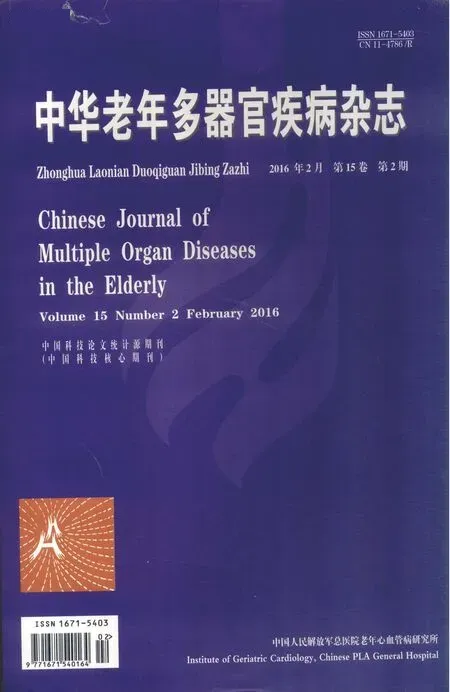年龄对急性ST段抬高型心肌梗死患者急诊行经皮冠状动脉介入治疗术后发生对比剂诱发的急性肾损伤的影响
王 雅,杜占奎,王效增,顾若曦,何瑞霞,周铁楠,韩雅玲
年龄对急性ST段抬高型心肌梗死患者急诊行经皮冠状动脉介入治疗术后发生对比剂诱发的急性肾损伤的影响
王 雅,杜占奎,王效增*,顾若曦,何瑞霞,周铁楠,韩雅玲
(沈阳军区总医院心内科,沈阳 110016)
探讨不同年龄对急性ST段抬高型心肌梗死患者急诊行经皮冠状动脉介入治疗(PCI)术后,发生对比剂诱发的急性肾损伤(CI-AKI)的影响。回顾性分析2006年2月至2012年9月期间在沈阳军区总医院心内科监护病房住院的急性ST段抬高型心肌梗死且急诊行PCI术的患者1 685例。按年龄分为两组:<60岁组(=932)和≥60岁组(=753)。比较两组患者的临床资料,对单因素分析有统计学意义的指标进行多因素logistic 回归分析,筛选出独立的危险因素。同时观察术后1个月、6个月、1年及3年两组患者发生主要心脏不良事件(MACE)和全因死亡的相关情况。≥60岁组患者CI-AKI发病率高于<60岁组患者(14.7%8.6%,<0.001)。年龄、既往心肌梗死病史和对比剂剂量是CI-AKI发生的危险因素。术后3年,≥60岁组患者的累积全因死亡率和心源性死亡率均明显高于<60岁组患者(4.2%1.5%,<0.001;1.5%0.2%,=0.011)。临床医师应慎重对待高龄患者,在术前充分评估患者心功能,在术中尽量精准使用对比剂剂量,以期预防CI-AKI的发生。
年龄;急性ST段抬高型心肌梗死;急诊;经皮冠状动脉介入治疗;对比剂诱发的急性肾损伤
随着冠状动脉介入治疗的普及,经皮冠状动脉介入治疗(percutaneous coronary intervention,PCI)术已作为目前治疗冠状动脉粥样硬化性心脏病的主要方法。但是PCI术中对比剂的广泛应用,使得对比剂诱发的急性肾损伤(contrast-induced acute kidney injury,CI-AKI)的发病逐年增加。目前,CI-AKI已成为PCI术后的主要并发症之一,在正常人群中的发生率约为6%~11%[1],在高危人群中的发生率高达50%[2]。既往研究表明[3−6],慢性肾功能不全、年龄、对比剂应用剂量、糖尿病、心功能不全、急诊PCI等因素是CI-AKI发生的高危因素。CI-AKI目前暂无有效的治疗方法,因此早期防治至关重要。本研究拟在不同年龄组患者中,观察急性ST段抬高型心肌梗死急诊行PCI术后CI-AKI的发生情况。
1 对象与方法
1.1 研究对象
入选2006年2月至2012年9月期间在沈阳军区总医院心内科监护病房住院的急性ST段抬高型心肌梗死且急诊行PCI术的患者1 685例。纳入标准:(1)年龄≥18岁;(2)明确诊断为急性ST段抬高型心肌梗死;(3)发病时间至就诊时间<12h;(4)行急诊冠状动脉造影及PCI术。排除标准:(1)年龄<18周岁;(2)对比剂过敏;(3)恶性肿瘤;(4)需要替代治疗的慢性肾功能不全;(5)需行冠状动脉搭桥(coronary artery bypass grafting,CABG)术的急性冠脉综合征患者。按年龄分为两组:<60岁组(=932)和≥60岁组(=753)。
CI-AKI诊断标准[7]:对比剂应用后72h内发生的急性肾功能损害,血清肌酐值较基线绝对升高0.5mg/dl(44.2µmol/L)或相对升高25%,同时排除其他肾脏损害因素。
1.2 方法
患者急诊PCI术前常规口服阿司匹林(aspirin;300mg)和氯吡格雷(clopidogrel;600mg负荷剂量)。术后24h内应用水化治疗[0.9%的氯化钠生理盐水,以1ml/(kg·h)的速度静脉输入]。术后阿司匹林(100~300mg,1次/d)长期服用;氯吡格雷(150mg,1次/d;2周后改为75mg,1次/d)服用12个月;他汀类调脂药长期口服。测定患者入院后的血清肌酐浓度,并在应用对比剂48h和(或)72h后测定血清肌酐浓度,若48h及72h均有测定,则按最高值记录。
1.3 随访及终点事件
PCI术后1个月、6个月、1年、3年分别通过电话、信函、邮件、门诊或入院等方式对入组患者进行随访。随访内容包括患者发生主要心脏不良事件(major adverse cardiovascular events,MACE)和全因死亡的情况。
MACE包括:心源性死亡、非致死性心肌梗死、再次血管重建(靶血管血运重建、非靶血管血运重建)。
心源性死亡:因急性心肌梗死、心脏穿孔、心包填塞、心律失常或传导异常、以及心脏原因导致的任何死亡[8]。
1.4 统计学处理

2 结 果
2.1 两组患者基线资料比较
两组患者在性别、体质量指数(body mass index,BMI)、吸烟史、白细胞计数、红细胞压积、高脂血症间的差异均具有统计学意义(<0.05;表1)。
2.2 两组患者冠状动脉造影术及PCI术情况比较
两组患者的病变部位及术中应用对比剂类型间的差异有统计学意义(<0.05;表2)。
2.3 两组患者CI-AKI发病率及围术期用药情况比较
与<60岁组患者相比,≥60岁组患者的术前血清肌酐浓度[(86.8±18.0)(90.8±23.0)µmol/L,=0.011]和术后血清肌酐浓度[(90.4±18.6)(96.6±27.7)µmol/L,<0.001]均显著增加。≥60岁组患者CI-AKI发病率高于<60岁组患者(14.7%8.6%,<0.001)。与<60岁组相比,≥60岁组围手术期应用β受体阻滞剂的患者显著减少(81.2%76.2%,=0.012)、应用利尿剂的患者显著增加(58.6%72.6%,<0.001)。
2.4 CI-AKI的危险因素分析
两组患者间具有显著性差异的变量以及既往文献中曾报道的可能危险因素包括:性别、年龄、BMI、既往心肌梗死、高脂血症、白细胞计数、红细胞压积、对比剂剂量、对比剂类型、病变部位、服用β受体阻滞剂、服用利尿剂、服用他汀类药物、高血压、糖尿病。以上述因素为候选自变量,以有无发生CI-AKI为因变量,采用插入法进行变量筛选,检验水准为α=0.05,得到logistic回归方程。结果显示年龄、既往心肌梗死病史和对比剂剂量是CI-AKI发生的危险因素(表3)。
2.5 患者终点事件的发生情况
两组患者PCI术后1个月(3.3%2.7%,=0.443)、6个月(3.2%3.6%,=0.694)、1年(8.6%6.6%,=0.113)的MACE发生率间差异无统计学意义。两组患者术后1年全因死亡率差异无统计学意义(0.8%0.4%,=0.356)。
PCI术后3年,随访≥60岁组患者689例(93.0%),<60岁组患者848例(92.0%),结果显示:MACE发生率间差异无统计学意义(12.3%13.7%,=0.433);≥60岁组患者的累积全因死亡率和心源性死亡率均明显高于<60岁组患者(4.2%1.5%,<0.001;1.5%0.2%,=0.011)。
3 讨 论
急性心肌梗死患者常合并心功能不全,此类患者因血流动力学不稳定及低血压状态,极易导致肾灌注不良,从而会增加CI-AKI的发病风险[9]。同时,对比剂的应用会增加血红蛋白的氧结合力,导致氧气不能输送至外髓质,致外周组织受损[10]。此外,急诊PCI水化不充分也会使CI-AKI的发病风险增高[11]。CI-AKI与冠状动脉粥样硬化性心脏病患者PCI术后发生临床不良事件密切相关[12,13]。目前,CI-AKI尚无有效的治疗手段,因此早期识别危险因素及合理预防至关重要。本研究主要分析不同年龄组急性ST段抬高型心肌梗死患者行急诊PCI后发生CI-AKI的情况。
既往研究表明,CI-AKI的发生与慢性肾病、高龄、对比剂应用剂量、糖尿病、心功能不全、急诊PCI等因素相关。本研究结果提示:≥60岁组患者CI-AKI发病率高于<60岁组患者(14.7%8.6%,<0.001)。logistic回归分析显示年龄是发生CI-AKI的独立危险因素,与既往研究一致[14]。其原因为老年患者肾脏代谢缓慢,对比剂应用后,更易引起肾脏血流动力学改变、肾髓质缺氧、肾小管中毒等情况[15]。

表1 两组患者基线资料比较
BMI: body mass index; LVEF: left ventricular ejection fraction; hs-CRP: high-sensitivity C-reactive protein; PCI: percutaneous coronary intervention

表2 两组患者病变部位及应用对比剂情况比较
PCI: percutaneous coronary intervention

表3 CI-AKI的logistic回归分析
CI-AKI: contrast-induced acute kidney injury; OR: odds ratio; CI: confidence interval
本研究发现,与<60岁组相比,≥60岁组围手术期应用利尿剂的患者显著增加(58.6%72.6%,<0.001)。提示对于急性ST段抬高型心肌梗死急诊行PCI的老年患者,术前减少利尿剂ST段抬高型的应用可能会降低CI-AKI的发生。
2012年KDIGO指南[16]中指出,高渗性对比剂发生CI-AKI的危险性高于等渗性对比剂和低渗性对比剂,对于等渗性对比剂与低渗性对比剂的优劣性尚待进一步验证。本研究中多因素回归分析显示对比剂剂量是CI-AKI发生的独立危险因素。
两组患者PCI术后1个月、6个月、1年的MACE发生率间差异无统计学意义。术后3年,≥60岁组患者的累积全因死亡率和心源性死亡率均明显高于<60岁组患者。考虑CI-AKI发生对老年患者死亡率影响可能较大。
本研究发现,年龄、既往心肌梗死病史和对比剂剂量是急性ST段抬高型心肌梗死急诊行PCI术患者发生CI-AKI的危险因素。提示临床医师应慎重对待高龄患者,在术前充分评估患者心功能,在术中尽量精准使用对比剂剂量,以期预防CI-AKI的发生。
[1] Nash K, Hafeez A, Hou S. Hospital-acquired renal insufficiency[J]. Am J Kidney Dis, 2002, 39(5): 930−936.
[2] Mehran R, Aymong ED, Nikolsky E,. A simple risk score for prediction of contrast-induced nephropathy after percutaneous coronary intervention: development and initial validation[J]. J Am Coll Cardiol, 2004, 44(7): 1393−1399.
[3] Nough H, Eghbal F, Sohani M,. Incidence and main determinants of contrast-induced nephropathy following coronary angiography or subsequent balloon angioplasty[J]. Cardiorenal Med, 2013, 3(2): 128−135.
[4] Narula A, Mehran R, Weisz G,. Contrast-induced acute kidney injury after primary percutaneous coronary intervention: results from the HORIZONS-AMI substudy[J]. Eur Heart J, 2014, 35(23): 1533−1540.
[5] Marenzi G, Cabiati A, Bertoli SV,. Incidence and relevance of acute kidney injury in patients hospitalized with acute coronary syndromes[J]. Am J Cardiol, 2013, 111(6): 816−822.
[6] Wang XC, Fu XH, Wang YB,. Prediction of contrast-induced nephropathy in diabetics undergoing elective percutaneous coronary intervention: role of the ratio of contrast medium volume to estimated glomerular filtration rate[J]. Chin Med J (Engl), 2011, 124(6): 892−896.
[7] Thomsen HS, Morcos SK. Contrast media and the kidney: European Society of Urogenital Radiology (ESUR) guidelines[J]. Br J Radiol, 2003, 76(908): 513−518.
[8] Cutlip DE, Windecker S, Mehran R,. Clinical end points in coronary stent trials: a case for standardized definitions[J]. Circulation, 2007, 115(17): 2344−2351.
[9] Kowalczyk J, Lenarczyk R, Kowalski O,. Risk stratification according to the type of impaired renal function in patients with acute myocardial infarction treated with percutaneous coronary intervention[J]. Kardiol Pol, 2007, 65(6): 635−643.
[10] Persson PB, Patzak A. Renal haemodynamic alterations in contrast medium-induced nephropathy and the benefit of hydration[J]. Nephrol Dial Transplant, 2005, 20(Suppl 1): i2−i5.
[11] James MT, Samuel SM, Manning MA,. Contrast-induced acute kidney injury and risk of adverse clinical outcomes after coronary angiography: a systematic review and meta-analysis[J]. Circ Cardiovasc Interv, 2013, 6(1): 37−43.
[12] Solomon RJ, Mehran R, Natarajan MK,. Contrast-induced nephropathy and long-term adverse events: cause and effect[J]? Clin J Am Soc Nephrol, 2009, 4(7): 1162−1169.
[13] James MT, Ghali WA, Knudtson ML. Associations between acute kidney injury and cardiovascular and renal outcomes after coronary angiography[J]. Circulation, 2011, 123(4): 409−416.
[14] Solomon R, Dauetrnan HL, Contrast-induced acute kidney injury[J]. Circulation, 2010, 122(23): 2451−2455.
[15] Epstein M. Aging and the kidney[J]. J Am Soc Nephrol, 1996, 7(8): 1106−1122.
[16] Fliser D, Laville M, Covic A,. An European Renal Best Practice (ERBP) position statement on the Kidney Disease Improving Global Outcomes (KDIGO) clinical practice guidelines on acute kidney injury: part 1: definitions, conservative management and contrast-induced nephropathy[J]. Nephrol Dial Transplant, 2012, 27(12): 4263−4272.
(编辑: 吕青远)
Influence of age on contrast-induced acute kidney injury in acute ST-segment elevation myocardial infarction patients after emergency percutaneous coronary intervention
WANG Ya, DU Zhan-Kui, WANG Xiao-Zeng*, GU Ruo-Xi, HE Rui-Xia, ZHOU Tie-Nan, HAN Ya-Ling
(Department of Cardiology, General Hospital of Shenyang Military Command, Shenyang 110016, China)
To determine the influence of different ages on the incidence of contrast-induced acute kidney injury (CI-AKI) in acute ST-segment elevation myocardial infarction patients after undergoing emergency percutaneous coronary intervention (PCI).A retrospective study was carried out on 1 685 ST-segment elevation acute myocardial infarction patients undergoing emergency PCI and stent implantation in the ICU of our department from February 2006 to September 2012. They were divided into the <60 years old group (=932) and the ≥60 years old group (=753). The clinicaldata were compared between the 2 groups. Multivariatelogisticregressionanalysis was used to detect the significant indicators obtained by univariate analysisto screenindependent risk factors. The occurrences of major adverse cardiovascular events (MACE) and all-cause mortality were observed in 1 and 6 months, and 1 and 3 years after surgery.The incidence of CI-AKI was significantly higher in the ≥60 years old group than in the <60 years old group (14.7%8.6%,<0.001). Age, previous myocardial infarction, and volume of contrast were independent risk factors for CI-AKI. During the 3 years’ follow-up after PCI, the cumulative all-cause mortality and cardiac mortality were significantly higher in the ≥60 years old group than in the <60 years old group (4.2%1.5%,<0.001; 1.5%0.2%,=0.011).Clinicians should treat the elderly patients with caution, and fully assess their preoperative cardiac function and precisely determine contrast volume to prevent the occurrence of CI-AKI.
age; acute ST-segment elevation myocardial infarction; emergency; percutaneous coronary intervention; contrast-induced acute kidney injery
(2013225089).
R541.4
A
10.11915/j.issn.1671-5403.2016.02.023
2015−12−10;
2015−12−30
辽宁省科学计划项目(2013225089)
王效增, E-mail: wxiaozeng@163.com

